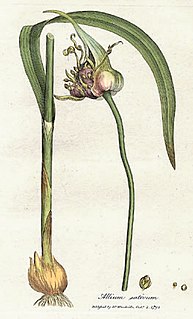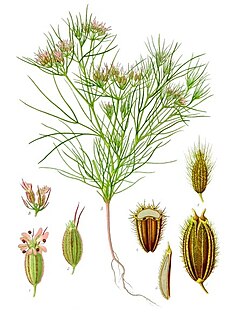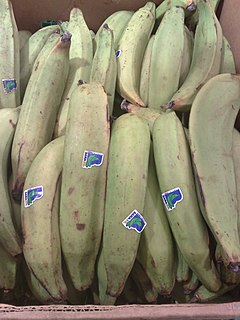
Cooking bananas are banana cultivars in the genus Musa whose fruits are generally used in cooking. They may be eaten ripe or unripe and are generally starchy. Many cooking bananas are referred to as plantains or green bananas, although not all of them are true plantains. Bananas are treated as a starchy fruit with a relatively neutral flavour and soft texture when cooked. Bananas fruit all year round, making them a reliable all-season staple food.

Costa Rican cuisine is known for being fairly mild, with high reliance on fresh fruits and vegetables. Rice and black beans are a staple of most traditional Costa Rican meals, often served three times a day. Costa Rican fare is nutritionally well rounded, and nearly always cooked from scratch from fresh ingredients. Due to the location of the country, tropical fruits and vegetables are readily available and included in the local cuisine.

Puerto Rican cuisine has its roots in the cooking traditions and practices of Europe, Africa and the native Taínos. Starting from the latter part of the 19th century, the cuisine of Puerto Rico has been greatly influenced by the United States in the ingredients used in its preparation. Puerto Rican cuisine can be found in several other countries.

Fufu is a staple food common in many countries in West Africa such as Cote D'Ivoire, Sierra Leone, Ghana, Liberia, Togo and Nigeria. It is often made in the traditional Ghanaian and Nigerian method by mixing and pounding separate equal portions of cassava and green plantain flour thoroughly with water. It is then adjusted to either increase or decrease the viscosity of the fufu depending on personal preferences. Other flours, such as semolina, maize flour or mashed plantains may take the place of cassava flour. Fufu is often served with groundnut soup, palm nut soup, abunuabunu or light soup.

Czech cuisine has both influenced and been influenced by the cuisines of surrounding countries. Many of the cakes and pastries that are popular in Central Europe originated within the Czech lands. Contemporary Czech cuisine is more meat-based than in previous periods; the current abundance of farmable meat has enriched its presence in regional cuisine. Traditionally, meat has been reserved for once-weekly consumption, typically on weekends. The body of Czech meals typically consists of two or more courses; the first course is traditionally soup, the second course is the main dish, and the third course can include supplementary courses, such as dessert or compote. In the Czech cuisine, thick soups and many kinds of sauces, both based on stewed or cooked vegetables and meats, often with cream, as well as baked meats with natural sauces (gravies), are popular dishes.

Ugandan cuisine consists of traditional and modern cooking styles, practices, foods and dishes in Uganda, with English, Arab, and Asian influences.
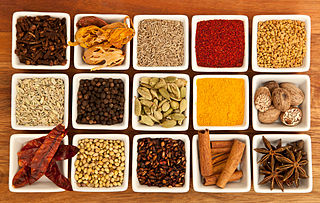
The cuisine of Karnataka includes many vegetarian and non-vegetarian cuisines. It is one of the oldest surviving cuisines and traces its origin to the Iron Age. Ragi is mentioned in the historical works of the great poet Adikavi Pampa and in the ancient Sanskrit medical text Sushruta Samhita. The varieties of the Karnataka cuisine have drawn influence from and influenced the cuisines of neighbouring states like Tamil Nadu, Andhra Pradesh and Kerala. Although the ingredients differ from one region to another, a typical Kannadiga Oota includes the following dishes in the order specified and is served on a banana leaf: Uppu (salt), Kosambari, Pickle, Palya, Gojju, Raita, Payasa (Kheer), Thovve, Chitranna, Anna (rice), and Tuppa (ghee).

Compared to other regional Indian cuisines, Odia cuisine uses less oil and is less spicy while nonetheless remaining flavourful. Rice is the staple food of this region. Mustard oil is used in some dishes as the cooking medium, but ghee is preferred in temples. In old times food was traditionally served on banana leaves or disposable plates made of sal leaves.

Colombian cuisine is a compound of the culinary traditions of the six main regions within the country. Colombian cuisine varies regionally and is particularly influenced by Indigenous Colombian, Spanish, and African cuisines, with slight Arab influence in some regions. Furthermore, being one of the most biodiverse countries in the world, Colombia has one of the widest variety of available ingredientes depending on the region.

The cuisine of the Democratic Republic of the Congo varies widely, representing the food of indigenous people. Cassava is generally the staple food usually eaten with other side dishes.
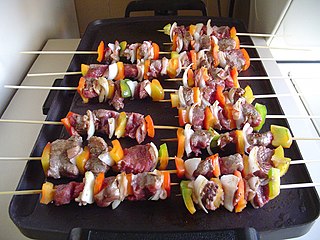
Honduran cuisine is a fusion of indigenous (Lenca) cuisine, Spanish cuisine, Caribbean cuisine and African cuisine. There are also dishes from the Garifuna people. Coconut and coconut milk are featured in both sweet and savory dishes. Regional specialties include fried fish, tamales, carne asada and baleadas. Other popular dishes include meat roasted with chismol and carne asada, chicken with rice and corn, and fried fish with pickled onions and jalapeños. In the coastal areas and in the Bay Islands, seafood and some meats are prepared in many ways, some of which include coconut milk.

Dominican Republic cuisine is predominantly made up of a combination of Spanish, indigenous Taíno, and African influences. Many Middle-Eastern dishes have been adopted into Dominican cuisine, such as the "Quipe" that comes from the Lebanese kibbeh. Dominican cuisine resembles that of other countries in Latin America, those of the nearby islands of Puerto Rico and Cuba, most of all, though the dish names differ sometimes.

A banana peel, also called banana skin in British English, is the outer covering of the banana fruit. Banana peels are used as food for animals, in water purification, for manufacturing of several biochemical products as well as for jokes and comical situations.

Nigerian cuisine consists of dishes or food items from the hundreds of ethnic groups that comprise Nigeria. Like other West African cuisines, it uses spices and herbs with palm or groundnut oil to create deeply flavored sauces and soups. Nigerian feasts are colourful and lavish, while aromatic market and roadside snacks cooked on barbecues or fried in oil are plentiful and varied.
Belizean cuisine is an amalgamation of all ethnicities in the nation of Belize and their respectively wide variety of foods. Breakfast often consists of sides of bread, flour tortillas, or fry jacks that are often homemade and eaten with various cheeses. All are often accompanied with refried beans, cheeses, and various forms of eggs, etc. Inclusive is also cereal along with milk, coffee, or tea.
A great variety of cassava-based dishes are consumed in the regions where cassava is cultivated, and they include many national or ethnic specialities.

Manipuri cuisine is the traditional cuisine of Manipur, a state of India. Dishes are typically spicy foods that use chili pepper rather than garam masala. Oil is uncommon in most Manipuri styles. The cuisine here in the state similar to the cuisines of Southeast/East/Central Asia, Siberia, Micronesia and Polynesia.

